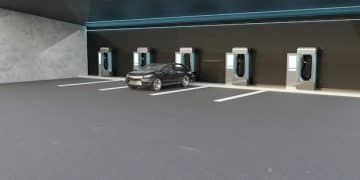Decoding the Infrastructure Bill’s EV Impact on the US Auto Industry

The Infrastructure Investment and Jobs Act allocates $7.5 billion to expand the electric vehicle charging station network across the US, significantly impacting the auto industry by encouraging EV adoption, stimulating infrastructure development, and potentially reshaping market dynamics and consumer behavior.
The US auto industry is on the cusp of a major transformation, largely driven by the increasing adoption of electric vehicles (EVs). A pivotal factor in this shift is the Infrastructure Investment and Jobs Act, earmarking $7.5 billion for the development of a nationwide network of EV charging stations, and decoding the impact of the Infrastructure Bill’s $7.5 Billion Investment in Electric Vehicle Charging Stations on the US Auto Industry.
Understanding the Infrastructure Bill’s EV Charging Station Investment
The Infrastructure Investment and Jobs Act represents a significant commitment by the US government to accelerate the adoption of electric vehicles. A core component of this initiative is the dedicated $7.5 billion investment aimed specifically at expanding the nation’s EV charging infrastructure.
The Scope of the Investment
This funding isn’t just about building more charging stations; it encompasses a comprehensive approach to creating a robust and accessible charging network. The investment targets various aspects, including:
- Deployment of fast-charging stations: Focusing on strategic locations along major transportation corridors to alleviate range anxiety.
- Grants and incentives for states and local governments: Encouraging them to invest in and manage charging infrastructure projects.
- Support for private sector involvement: Facilitating partnerships and investments from companies involved in EV charging.
The aim is to ensure that EV charging is convenient, reliable, and readily available, thereby encouraging more consumers to make the switch to electric vehicles.

This investment is strategic for the expansion of electric vehicle infrastructure and is intended to support consumer adoption of EVs.
Impact on Electric Vehicle Adoption Rates
One of the most direct and anticipated outcomes of the Infrastructure Bill’s investment in EV charging stations is its potential to accelerate the adoption rate of electric vehicles across the United States. A widespread and reliable charging network addresses a major concern for potential EV buyers: range anxiety.
Consumer Confidence and Market Growth
With greater access to charging stations, consumers are more likely to feel confident in their ability to travel long distances and navigate daily commutes without worrying about running out of power. This increased confidence can lead to:
- Higher demand for EVs: As charging infrastructure expands, more consumers will consider EVs as a viable option.
- Growth in the EV market: Increased demand will stimulate further development and production of electric vehicles.
- Reduced reliance on gasoline-powered vehicles: As EVs become more practical, the market share of traditional vehicles is likely to decrease.
The investment in charging infrastructure is expected to directly correlate with increased EV sales and market penetration.
This is why several automakers are setting targets for EV adoption and production.
Reshaping the US Auto Industry Landscape
The ripple effects of the Infrastructure Bill’s investment extend beyond just EV adoption rates; it is poised to reshape the entire landscape of the US auto industry. This transformation will impact automakers, suppliers, and related sectors.
Automakers and Production Strategies
Automakers are already responding to the growing demand for EVs. The expanded charging network incentivizes manufacturers to:
- Increase EV production: Automakers are investing heavily in EV manufacturing facilities and technologies.
- Develop a wider range of EV models: To cater to different consumer needs and preferences.
- Enhance battery technology: Improving range, charging speed, and battery lifespan.
This shift requires significant investments in research and development, as well as retooling of existing manufacturing facilities.
The increased EV use is predicted to reshape the auto industry which is expected to invest in new technology and production strategies.
Opportunities for Infrastructure Development and Job Creation
The $7.5 billion investment in EV charging stations not only supports the auto industry but also unlocks substantial opportunities for infrastructure development and job creation across various sectors. Building a nationwide charging network requires a collaborative effort involving construction companies, electrical contractors, technology providers, and more.
Economic Stimulus and Workforce Expansion
The development of EV charging infrastructure will:
- Create jobs in construction and installation: Building and setting up charging stations requires skilled labor.
- Stimulate economic activity in local communities: Charging stations can attract businesses and customers to surrounding areas.
- Foster innovation in charging technology: Companies will be driven to develop more efficient and cost-effective charging solutions.
This investment will likely have a positive impact on employment rates. These initiatives are also key to the industry’s ongoing evolution.

Challenges and Potential Roadblocks
While the Infrastructure Bill’s investment holds immense promise for the EV industry, it is crucial to acknowledge the challenges and potential roadblocks that may arise during implementation. Overcoming these obstacles will be key to ensuring the successful deployment of the charging infrastructure.
Ensuring Equitable Access and Reliability
Some challenges include:
- Equitable distribution of charging stations: Ensuring that charging infrastructure is available in both urban and rural areas, and in underserved communities.
- Standardization of charging protocols: Making it easier for EV owners to use different charging networks.
- Cybersecurity risks: Protecting charging stations from cyberattacks that could disrupt service.
Addressing these challenges will require careful planning, collaboration among stakeholders, and ongoing monitoring of the charging network’s performance.
Considerations for roadblocks are essential to the expansion of EV charging stations.
The Long-Term Vision for Electric Mobility
The Infrastructure Bill’s investment in EV charging stations is more than just a short-term economic stimulus; it represents a long-term vision for the future of electric mobility in the United States. This investment lays the foundation for a cleaner, more sustainable transportation system.
Creating a Sustainable Transportation Ecosystem
The long-term vision involves:
- Integration of renewable energy sources: Powering charging stations with solar, wind, and other renewable energy sources.
- Development of smart charging technologies: Optimizing energy consumption and reducing strain on the electricity grid.
- Promoting public-private partnerships: Leveraging the expertise and resources of both sectors to accelerate EV adoption.
This vision sets the stage for a future where electric vehicles are not just a niche market but the dominant mode of transportation.
Considerations for the environment are essential to the expansion of EV charging stations.
| Key Point | Brief Description |
|---|---|
| 💰 Investment Size | $7.5 billion allocated for EV charging infrastructure. |
| 📈 Adoption Rates | Accelerates EV adoption by addressing range anxiety. |
| 🛠 Auto Industry | Reshapes production, focusing on EV manufacturing. |
| 🌎 Sustainability | Promotes cleaner transportation and reduces emissions. |
FAQ
▼
The Infrastructure Investment and Jobs Act allocates $7.5 billion for building out a national network of electric vehicle charging stations.
▼
By expanding the charging infrastructure, it aims to alleviate range anxiety and make EVs a more practical choice for consumers, boosting adoption.
▼
Jobs will be created in construction, installation, maintenance, and technology development related to electric vehicle charging infrastructure.
▼
Challenges include ensuring equitable distribution of charging stations, standardizing charging protocols, and addressing cybersecurity risks.
▼
There is a focus on integrating renewable energy sources, such as solar and wind, to power the stations, promoting sustainability.
Conclusion
The Infrastructure Bill’s $7.5 billion investment in EV charging stations marks a pivotal moment for the US auto industry, driving EV adoption, fostering economic growth, and paving the way for a sustainable transportation ecosystem. While challenges remain, the long-term vision promises a cleaner, more innovative future for mobility in the United States.





